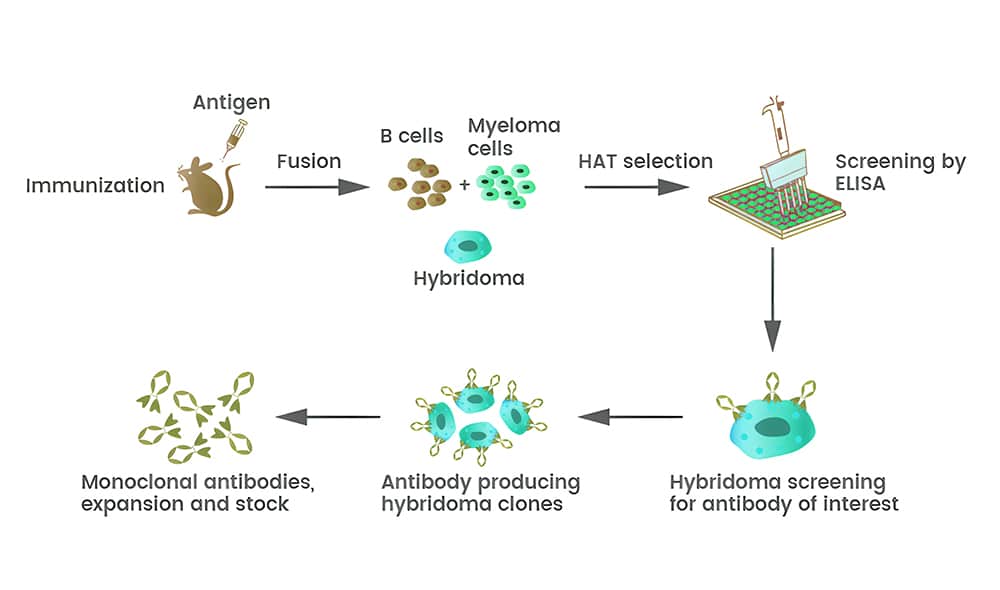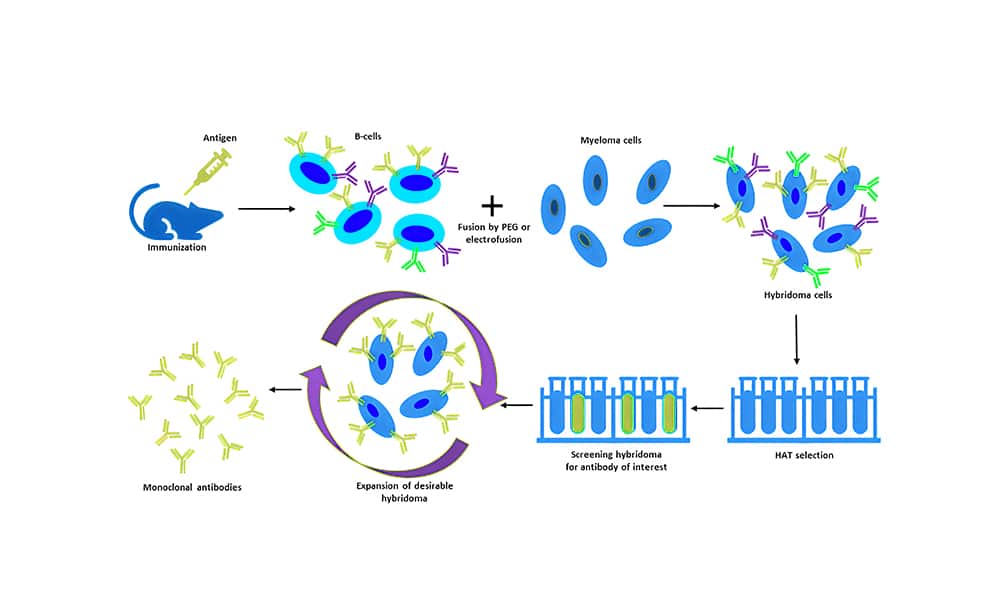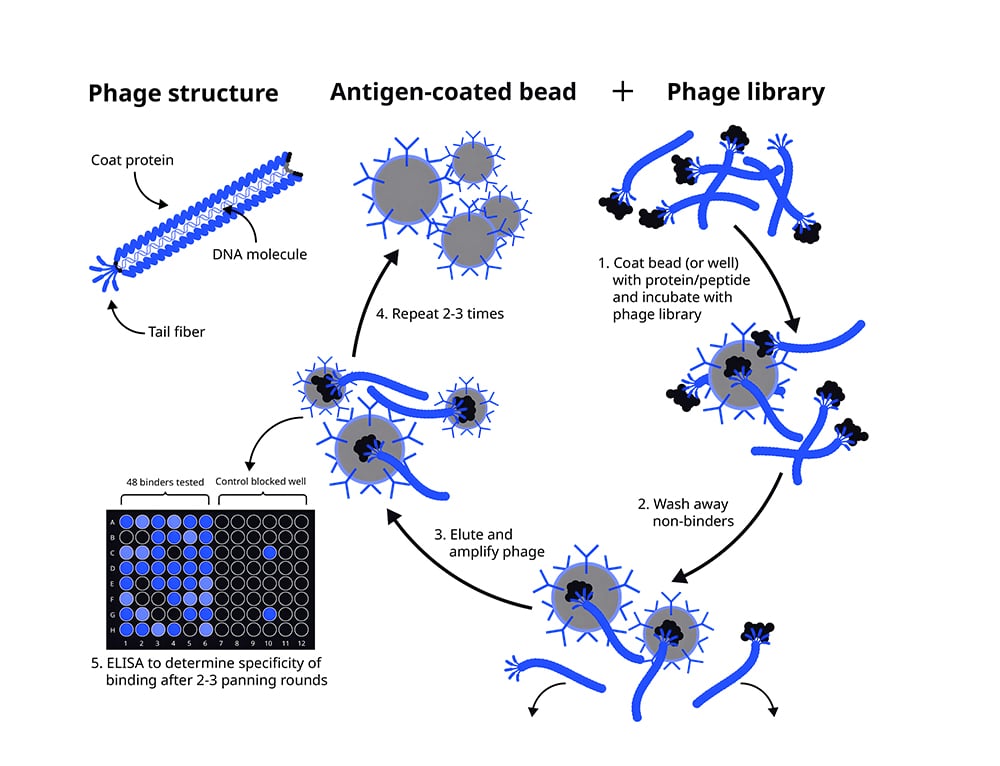Monoclonal Antibody Production
QYAOBIO provides different monoclonal antibody production for customers in worldwide
Monoclonal antibodies (mAbs) are highly uniform antibodies produced by a single B cell clone that target only a specific antigenic epitope. In contrast to polyclonal antibodies that target many structural regions (epitopes) of an antigen, mAbs show high specificity for one single epitope. Since then, mAbs are widely used as the essential tool of biomedical research and therapeutic applications. mAbs are the most important type of biologic drugs for diagnostic purposes.
MAb Production Technology
Several mAb generation technologies had been developed over the years, to isolate mAbs using hybridoma, display methods, and single B cell amplification. Each technology platform has the respective advantage, limitations, and applicability.

Hybridoma Technology

Hybridoma technology is the primitive mAb isolation, this methodology is most fundamental and successful. In this approach, after scientists inject animals with an antigen of interest, spleen cells are isolated and fused with myeloma cells to combine the properties of both cell types: antigen-specific antibody secretion and immortalization. This resulting fused cell is a hybridoma. Then the researchers screen thousands of hybridomas to identify the best one based on antigen specificity and immunoglobulin class and these candidates are subsequently analyzed, characterized, and scaled up for downstream processes. Hybridomas technology can be applied to generate a diverse library of unique mAbs at a large scale, which are widely used in the prevention, diagnosis, and treatment of disease.
The method relies on suitable immune responses of the injected animal to the antigen and requires humanization (chimeric antibodies) of the antibodies to reduce immunogenicity, meaning side effects due to being recognized as foreign by the patient’s immune system.
Phage Display

Antibody phage display is a versatile in vitro selection technology, which can be used to discover high affinity antibodies specific to against a variety of antigens. Using recombinant technology, the variable heavy and light genes of antibodies are fused in vitro to genes for surface peptides of bacteriophages. After introducing these genetic blueprints into bacterial cell cultures, the next generation of phages that display the antibody on their surface, which sets up a direct physical link between the amino acid sequence of antibodies and their encoding proteins. This allows scientists to generate antibody libraries displaying millions of different antibodies. These displaying phages are then screened against the antigen of interest, and those that are highly specific are identified, isolated, and further characterized for downstream work.
Phage display is a technique used to study the interaction of proteins displayed on the surface of a bacteriophage with other molecules such as peptides, DNA, and other proteins. It is commonly used to find high-affinity interactions between antibodies and antigens, which play a critical role in viral pathogenesis, vaccines, and other treatments.
Single B Cell Technologies
Single B cell antibody technology is a newly developed approach for rapidly discovering monoclonal antibodies from single B cells. Antigen-specific B cells are isolated from tissues or peripheral blood of immunized animals, then antibody variable region gene of a single B cell is extracted using PCR amplification technology. The gene products are expressed in in mammalian cells to obtain biologically active mAbs.
Today, a large variety of technologies for single-cell separation, isolation, and sorting are already available which mainly include: FACS (fluorescent activated cell sorting), LCM (laser-capture microdissection), microengraving, and droplet microfluidics.
MAb Production Steps
The production of mAbs from hybridomas includes several key steps, including immunization, hybridoma production, screening and cloning, and purification. These steps based on the production of monoclonal antibodies from hybridomas.
Immunization
An animal is injected with a target antigen, its immune system will recognize the antigen as foreign and produce an immune response. Then, the spleens of the mouse are harvested to obtain B cells that produce the desired antibody.
Cell Fusion
Myeloma cells are a type of cancerous B cell that can be grown indefinitely in the lab. Antibody-producing B cells are fused with myeloma cells to create hybridoma cells. The hybridoma cells generated through fusion will be capable of producing vast amounts of antibodies.
Screening and Cloning
The hybridoma cells are screened by ELISA technology to identify the cells that produce the desired antibody. ELISA involves coating a plate with the target antigen and then adding hybridoma cells to the plate. Once the hybridoma cell produces the desired antibody, it will bind to the antigen on the plate, then the antibody can be detected by a secondary antibody. After screening, desired hybridoma cells are cloned to create a stable cell population, and the culture is grown to collect large amounts of mAbs. This can be achieved through one of two methods.
- In-vitro hybrid cells growth in tissue culture.
- In vivo growth following inoculation of hybridoma cells into a mouse’s abdomen.
Purification
In order to separate the mAb from the other proteins and substances present in the cell culture, purification is required. This is typically performed using a combination of chromatographic techniques, such as ion exchange chromatography, size exclusion chromatography, and affinity chromatography.
MAb Advantages & Disadvantages
Advantages
- High Homogeneity: Batch-to-batch reproducibility.
- Can produce large quantities of identical antibodies (Facilitates diagnostic manufacturing and therapeutic drug development).
- High specificity to a single epitope, and reduces the risk of cross reactivity.
- More sensitive in assays with quantification requirement of the protein levels.
- Low background noise.
- Excellent for affinity purification.
Disadvantages
- More expensive to produce.
- Requires significantly more time (+/- 6 months) and high technical skills to produce.
- More susceptible to binding changes when labelled.
- Specificity and cross-reactivity: May cross-react with other antigens, leading to false-positive results or unexpected side effects.
- Less ideal for applications requiring rapid capture of target proteins.
- Immunogenicity: Causes an immune response in patients, leading to the production of anti-drug antibodies, which reduces the efficacy and may cause adverse effects.
Costom Mono-Antibody Service
Qyaobio is specialized in antibody discovery and development and harbors extensive experience in antibody generation using our comprehensive platform. Our offers comprehensive solutions for the generation and scaled production of custom monoclonal antibodies. Our experienced team will work with you from antigen design to antibody purification and validation. We offer several comprehensive antibody discovery platforms, including hybridoma, phage display, and single B-cell technologies, and we will utilize the most appropriate platform based on the target of interest, the antibody’s application, and the client’s timeline.
To ensure identification of the best antibody for research, diagnostics, and therapeutics, Qyaobio also offers a variety of characterization and screening technologies, including ELISA, WB, flow cytometry, IHC, cell-based screening, and affinity ranking.
Call Us
+86(021)-50795728
+86(027)-60707970
